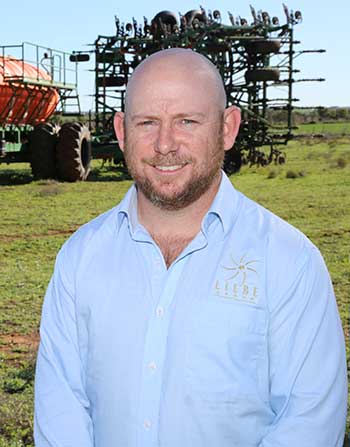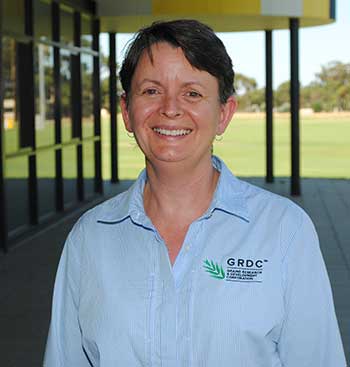Results from a two-year project to help lupin growers in Western Australia maximise establishment, yields and grain quality and reduce incidence of split seed have been released in a new podcast and video from GRDC.
Led by the Liebe Group, the project addresses grower concerns raised at GRDC National Grower Network (NGN) meetings about poor establishment of lupin crops, especially in newer varieties.
Lupins are grown across approximately 350,000 hectares in WA and are the state’s most widely grown pulse crop.
Manganese deficiency and seed damage during harvest activities have become increasingly evident in recent years, resulting in split seed and yield penalties as high as 70 per cent.
 Liebe Group project and support officer Chris O'Callaghan said the project explored managing manganese deficiencies as well as seed handling techniques to reduce split seed. Photo: Anvil Media
Liebe Group project and support officer Chris O'Callaghan said the project explored managing manganese deficiencies as well as seed handling techniques to reduce split seed. Photo: Anvil Media
Liebe Group's project and support officer Chris O'Callaghan said that following a benchmark study in 2019, the project has explored managing manganese deficiencies as well as seed handling techniques to reduce split seed, such as limiting auger journeys and adjusting rotor speeds.
“The benchmark study focused on 27 growers in the Dalwallinu area. This area of the Northern Agricultural region is known for lupin growing. In the sand plain soils, lupins have a lot of benefit including putting nitrogen into the soil, and are a good break crop,” Mr O’Callaghan said.
“When we looked at germination testing at harvest time, we found that an average of 96 per cent germination pre-harvest reduced to around 74 per cent post-harvest.
“One of the big key learnings has been around how you assess seed damage that can affect germination percentages.
“Growers knew about split seed being caused by manganese deficiency, that is a very visual thing. But some growers were not aware that there's also internal damage that can happen to lupin seeds through heavy machinery use.”
Recommendations from the project include harvesting under the right conditions, lowering the rotor speed of harvesters and limiting auger journeys.
“Number one, harvest at the right time: the recommendations are around 12 per cent moisture. You don't want to be harvesting when it's too hot or dry, or harvesting after rain,” Mr O’Callaghan said.
“Secondly, lower the rotor speed of your harvester. Machinery impacts can also result in split seeds, inhibiting establishment rates.
“Lastly, try to limit the number of auger journeys the seed takes. If possible, put it through a new auger. Research by the Department of Primary Industries (DPI) back in the 1990s suggested damaged augers can increase the damage to lupin seeds.
“One of the most important findings was, if you're unsure of your lupin seed quality, if you're getting a new batch of seed or you think there might be some damage to your lupin seed, get it tested through a proper germination test.”
Lupin grower Rob Nankivell has been growing pulses and cereals since the 1980s and is one of many growers harvesting, storing and using lupin seed. When GRDC and Liebe Group launched lupin trials in 2019, Rob jumped at the opportunity to participate.
For Rob, insights around managing manganese have prompted a change in practice with lupin crops, which may be used as seed for next year, getting a manganese-sulphate hit.
WA's sandy northern wheatbelt requires growers to apply a lot of lime to increase the pH of soils, but that makes manganese less available.
“We've learnt where we have the most issues is where we've put the most lime on, which were the most acidic soils,” Mr Nankivell said.
“To try and counteract it, we spray manganese on when the primary spike's got small pods on it, to try and boost the manganese in the plant to allow those pods, and the next order pods, to not have a manganese issue.”
Mr O’Callaghan said that while generally applying lime is a good thing for most crops, for lupins, which rely on manganese to improve the seed quality, it can be detrimental.
 GRDC grower relations manager west Jo Wheeler said that poor lupin establishment is important to address as it has a compounding negative impact on grower profitability. Photo: GRDC
GRDC grower relations manager west Jo Wheeler said that poor lupin establishment is important to address as it has a compounding negative impact on grower profitability. Photo: GRDC
“We're not saying don't apply lime, we're just saying make sure you're onto your manganese testing and applying additional manganese, when necessary, as well,” Mr O’Callaghan said.
GRDC grower relations manager west Jo Wheeler said that poor lupin establishment is important to address as it has a compounding negative impact on grower profitability.
“As well as impacting on yield, poor establishment can impact seeding rates, paddock coverage and weeds, as well as discouraging growers from adopting new varieties,” Ms Wheeler said.
“Results from this project, available via the new GRDC video and podcast, will assist growers to determine which factors affect seed integrity most and where in the handling processes practical changes can be made to improve germination.”
In addition to the podcast and video, growers can also watch the Liebe Group’s webinar, Best management practice to ensure lupin seed establishment.

























































